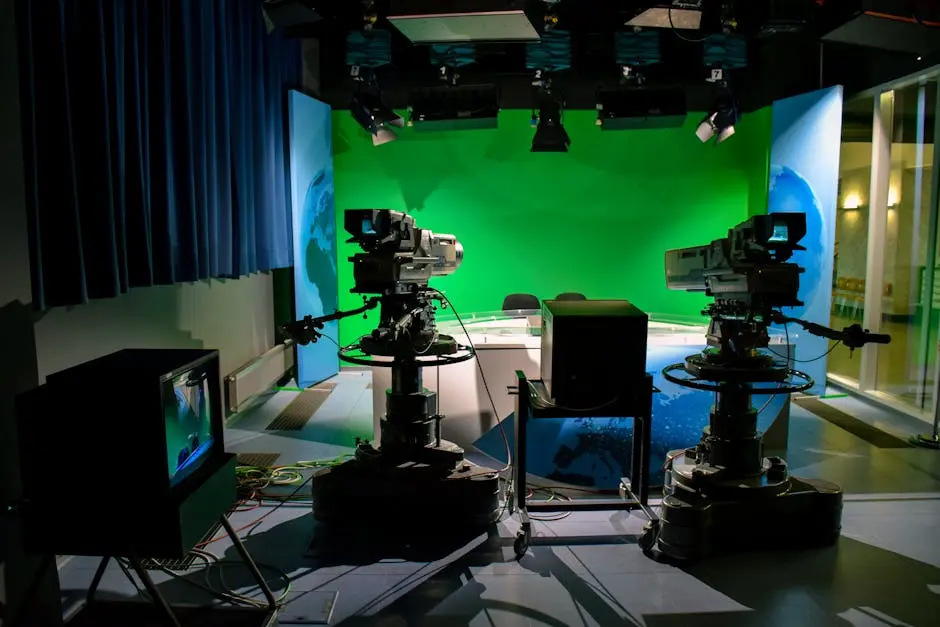As the entertainment landscape continues to evolve, TV studio production is undergoing a revolutionary transformation. This evolution is driven by a variety of emerging trends that are reshaping how content is created, produced, and consumed. In this listicle, we’ll explore some of the most influential trends shaping the future of TV studio production, offering insights into what lies ahead for the industry.
1. Virtual Reality Integration
Virtual reality is making waves in TV studios, offering immersive experiences and innovative ways to engage viewers. This technology allows creators to transport audiences to entirely new worlds, enhancing storytelling and expanding creative potential. Imagine watching a historical drama where viewers can virtually step into ancient times or a nature documentary where audiences are surrounded by the vibrant life of the rainforest. The possibilities are boundless, and as VR headsets become more accessible, more productions are likely to incorporate this exciting technology to captivate audiences like never before.
Incorporating VR into TV production is not without its challenges. Producers must reimagine how stories are told, considering the interactive nature of VR and its unique sensory elements. This requires a shift in traditional directing techniques, as scenes need to be constructed from a 360-degree perspective, providing viewers with the freedom to explore the virtual environment. Moreover, the integration of VR demands robust technical infrastructure due to the high data and processing requirements, prompting studios to invest in upgrading their facilities to support such groundbreaking experiences.
2. Automation and AI
Automation and artificial intelligence are streamlining production processes, from editing to live broadcasting. These technologies not only increase efficiency but also open up new creative possibilities by providing studios with advanced data analytics and insights. With AI, studios can automate mundane tasks, allowing creative professionals to focus more on innovation and storytelling rather than logistics. AI-driven software can analyze scripts and suggest changes to enhance narrative flow, predict audience preferences, and even customize content in real time, ensuring that productions are both efficient and appealing.
The integration of AI in TV production is transforming how content is managed and delivered. Predictive analytics can provide insights into viewer ratings and trends, helping producers adjust their strategies to meet audience demands more accurately. Moreover, AI can aid in detecting anomalies or errors during live broadcasts, ensuring smoother operations. As AI tools continue to evolve, they’ll become even more integral in decision-making processes, offering predictive insights that guide everything from casting choices to content distribution, thus maximizing reach and impact in increasingly competitive media landscapes.
3. Remote Production Tools
The rise of remote production tools has made it easier to collaborate across distances. This trend gained momentum during the global pandemic and continues to enable flexible studio setups, facilitating seamless workflows no matter where team members are located. Cloud-based platforms allow for the easy exchange of high-resolution media files, and remote editing suites are becoming standard, offering creatives the ability to log in from virtually anywhere. This increased flexibility not only makes productions more efficient but also helps attract a global talent pool, as geographical boundaries become less of a constraint for hiring the best in the field.
Despite the advantages, remote production does pose unique challenges. Coordinating among team members in different time zones requires excellent communication strategies, and maintaining a cohesive creative vision can be challenging when contributors are dispersed. Studios are increasingly investing in robust communication tools and platforms that provide high-quality video conferencing and real-time collaboration features to mitigate these issues. Training staff to maintain cybersecurity protocols is also essential to protect sensitive content as it moves between locations. Nonetheless, the advantages of remote collaboration, such as reduced travel costs and enhanced diversity in creative input, continue to outweigh these challenges, marking a new era in global TV production practices.
4. High Dynamic Range and 8K Resolution
Advancements in video quality, such as high dynamic range and 8K resolution, are enhancing the viewing experience. These technologies provide outstanding image clarity and vibrant colors, setting new standards for visual storytelling in TV production. With HDR, producers can ensure that every scene is meticulously detailed, capturing a wider range of colors and contrasts that more closely mimic what the human eye perceives. Similarly, 8K resolution offers unparalleled picture quality, making every pixel matter and allowing viewers to enjoy a level of detail that was previously unimaginable on TV.
The shift to higher resolutions and HDR means that studios have to update their equipment to keep pace with these technological advances. Cameras, editing software, and even display monitors must be compatible with these high-end formats, which can mean significant initial investments. However, these investments are worthwhile, as the demand for stunning visual content continues to grow, driven by consumer expectations for cinema-quality experiences at home. As more broadcasters and streaming services support HDR and 8K content, these become essential tools for staying competitive in the entertainment industry.
5. Content Personalization
Personalization has become a cornerstone of modern TV production, with studios leveraging data to tailor content to individual viewer preferences. This targeted approach helps engage audiences in more meaningful ways, fostering stronger connections with the content. Predictive algorithms track what viewers are watching, suggest similar shows, and even compile personalized playlists, all designed to keep audiences hooked. By creating a more customized viewing experience, studios can not only enhance audience satisfaction but also increase viewer retention, making personalization a powerful tool in competitive content markets.
However, with great data comes great responsibility. Studios must navigate privacy concerns, ensuring that personalization efforts respect viewer preferences and data confidentiality. By transparently communicating how data is used and implementing stringent data protection measures, producers can cultivate trust while enhancing personalization strategies. Additionally, the future could see the incorporation of real-time personalization, where content dynamically adjusts as viewers interact with it, offering an even more immersive, tailored viewing experience. As Artificial Intelligence continues to evolve, it could drive these personalization efforts, making them faster, more effective, and deeply integrated into the TV viewing landscape.
6. Sustainability Initiatives
Environmental consciousness is influencing TV studio operations, as more producers adopt sustainable practices. From energy-efficient equipment to waste reduction strategies, studios are playing a pivotal role in creating a more sustainable entertainment industry. Many productions are now integrating green policies, such as reducing electricity consumption on set and utilizing recycled materials for props and costumes. This not only helps reduce the carbon footprint of studio activities but also resonates with environmentally conscious audiences, strengthening studio reputations and demonstrating a commitment to social responsibility.
Collaborations with environmental organizations are on the rise, as studios seek to implement industry-wide standards and benchmarks for sustainability. This involves sharing best practices and innovations, inspiring other studios to adopt more eco-friendly operations. The momentum for sustainable production is supported by initiatives like carbon offset programs and the emerging trend of ‘green seals’ certifying sustainable shows. As awareness and demand for sustainability increase, these efforts are crucial in ensuring that TV production evolves responsibly, paving the way for a greener future while maintaining high-quality, engaging content.
7. Advanced Graphics and Animation
With improvements in technology, the use of advanced graphics and animation is on the rise. These elements add depth and realism to productions, making content more visually appealing and engaging for viewers. The innovations in computer-generated imagery (CGI) have allowed for the creation of breathtaking visuals that were once deemed impossible for regular TV budgets. Animated worlds and characters can now rival those seen in blockbuster films, giving TV productions the power to tell stories that are limited only by imagination.
The rise of advanced graphics comes concurrently with technological enhancement in rendering speeds and graphic software capabilities. As more sophisticated tools become available, they enable faster and more detailed animation work, which can be integrated seamlessly with live-action footage. This seamless integration is key for productions aiming to maintain viewers’ suspension of disbelief while exploring fantastical themes. Looking forward, as virtual production techniques evolve, which blend CGI and physical sets in real-time, the line between animation and reality will continue to blur, offering exciting new canvases for creative storytelling in television.
8. Live Streaming and Multi-platform Distribution
Live streaming has become an essential part of modern TV production, enabling real-time interaction and engagement with audiences. Additionally, multi-platform distribution ensures content reaches viewers wherever and whenever they choose to watch. These shifts are driven by consumer demand for anytime, anywhere access to content, making it imperative for studios to adapt. By distributing shows across a variety of platforms—from traditional TV networks to streaming services and social media—producers can significantly increase their reach and cater to diverse audience preferences.
The strategic deployment of content across multiple platforms requires a deep understanding of each platform’s unique audience and metrics. For live streaming, innovations such as low-latency streaming and interactive features are crucial, offering viewers the chance to engage directly through polls, comments, and Q&A sessions. This form of engagement is invaluable, fostering a sense of community and loyalty among audiences. Future trends may include even more integration with social media, where live shows could incorporate feedback in real-time, shaping narratives in response to audience interaction, and creating an unprecedented participatory viewing experience.


